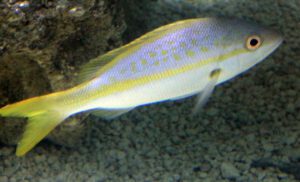
Commissioner Jean-Pierre L. Oriol congratulates staff in the Division of Fish & Wildlife on publishing one scientific peer-reviewed paper in the year 2024. Chief of Fisheries Sennai Habtes, Ph.D. co-authored a publication on the impact of invasive seagrass on juvenile yellowtail snapper.
- Costa, Sophia & Habtes, Sennai& Willette, Demian & Budd, Kayla & Kadison, E. & Vaughn, Kelsey & Nemeth, Richard. (2024). Impact of invasive seagrass Halophila stipulacea on life history characteristics of juvenile yellowtail snapper (Ocyurus chrysurus). Bulletin of Marine Science. 100. https://doi.org/10.5343/bms.2023.0151.
The study is one of the first of its kind to identify the direct effects of H. stipulacea during the early life history stages of a commercially important fish species in the Caribbean, the abstract states. This invasive seagrass is known to displace native Caribbean seagrass such as Syringodium filiforme and Thalassia testudinum, which provide important habitat for juvenile yellowtail snapper.
The research for the paper is based on monthly surveys conducted over the span of a year, from May 2020 to June 2021 at locations across southern St. Thomas, VI. A total of 260 juveniles were measured to compare their settlement and survivorship among different seagrass species.
The Division of Fish & Wildlife collaborates widely with agencies and research institutions to provide information on how to conserve, protect, and restore our ecosystems. These investigations represent high quality information on our ecosystems, animal populations, and methods to investigate the natural world. For any questions or more information or to request full text versions of these articles, please call the Division of Fish and Wildlife at DFWElectronic@usvi.onmicrosoft.com.

